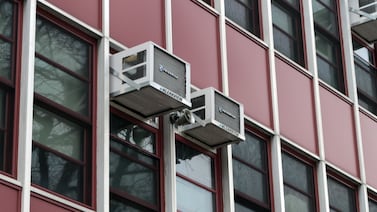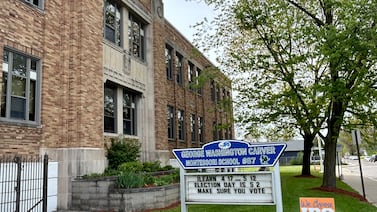The number of homeless students attending New York City schools reached a record high last year after thousands of asylum-seeking families entered the city’s shelter system, a new analysis shows.
Roughly 1 in 9 students were living in shelters, “doubled up” with relatives or friends, or otherwise without permanent housing at some point in the school year, according to state data compiled by Advocates for Children, a group that supports the city’s most vulnerable students.
The city’s population of homeless students was astronomical even before the recent influx, with the number of kids lacking permanent housing exceeding 100,000 for each of the past eight years – a stark indication of the city’s ongoing housing crisis.
But the sudden arrival of thousands of families fleeing dire conditions in Latin America and other parts of the world pushed the figure to nearly 120,000 last school year — a 14% increase over the previous school year. It’s an all-time high, even as the city’s overall student enrollment has plummeted, according to Advocates for Children, which has been crunching this number annually for more than a decade.
The number is likely to be even higher by the end of this school year. Roughly 12,500 new students in temporary housing have enrolled in city schools since July, according to an Education Department spokesperson.
“Our young people experiencing homelessness are some of our most vulnerable students, and it is our on-going priority to provide them with every support and resource at our disposal,” spokesperson Jenna Lyle said in a statement.
The increase has profound implications for city schools.
Homeless students face significant educational roadblocks, from the added logistical challenges of getting to school from distant shelters to the trauma that comes with losing permanent housing.
An astounding 72% of students living in homeless shelters were marked chronically absent last year — meaning they missed at least 18 days of school, according to data compiled by Advocates for Children. For all students in temporary housing, including those living doubled up, the rate was 54%, and for kids in permanent housing, it was 39%.
Students living in shelters were also more than four times as likely as kids with permanent housing to transfer schools last year, and less than half as likely to score proficient on state reading exams, according to the data.
Advocates fear the number of school transfers will spike even higher this year due to a new city rule that requires families in some shelters to exit the system every 60 days and either find alternative housing or re-apply for shelter. Families that re-apply would have no guarantee of ending up in the same shelter or even the same borough.
Mayor Eric Adams said the new policy is necessary to relieve severe overcrowding in shelters and free up space for new arrivals. He promised the city would work to ensure that students don’t have to transfer schools whenever possible.
Students who end up in homeless shelters far from their schools are entitled under federal law to transportation so they don’t have to transfer, but given the difficulty of coordinating the rides and the stress of the long commutes on families, that often amounts to “a right in name only,” said Jennifer Pringle, the director of Advocates for Children’s Learners in Temporary Housing project.
An Education Department spokesperson said district superintendents will ensure that transportation requests from homeless students are prioritized.
Schools go all out to help homeless students
Schools often devote considerable resources to supporting families in temporary housing with everything from transportation to basic needs like laundry.
At VOICE charter school in Long Island City, Queens, a sudden explosion of enrollment of students in shelters transformed educators’ approach to working with families.
Historically, the K-8 school enrolled no more than 20 homeless students in a year, said Principal Franklin Headley. But last year, given the school’s proximity to a cluster of recently converted shelters housing asylum-seeking families and an effective outreach strategy, the school enrolled hundreds of newly arrived families. It now serves roughly 270 students in temporary housing, Headley said.
The school’s 15-person operations team pivoted to focus almost exclusively on supporting the newly arrived families, fanning out to shelters to survey families’ needs and establish relationships with shelter staff, said Director of Operations Karina Chalas.
That work yielded several new school initiatives, including an after-school program to help parents who needed child care (because of shelter rules prohibiting them from leaving kids alone) and a laundry room for families without washers and dryers in their shelters.
Staff worked hard to keep attendance tabs on the new arrivals, even as families moved to new cities and states or transferred to shelters in other parts of the city. The school helped arrange bus or train transportation when possible for families who moved to different neighborhoods so kids didn’t have to transfer schools.
“They built a community here already,” Chalas said. “We try as hard as we can to give them any option of ‘here’s what we can do.’ After a while, if it becomes too much, we know as a school we tried everything we can do.”
Budget woes could unleash more instability for homeless students
All that support requires additional resources and expertise – and advocates say the city is still not providing enough help.
A city Education Department initiative last year that hired 100 new staffers, called community coordinators, to work directly in shelters to support families with educational needs is funded by one-time federal pandemic aid that expires at the end of this year.
Meanwhile, a plan to hire an additional 12 staffers this year to support homeless students is on hold because of a hiring freeze related to city budget cuts, advocates said.
“Losing the shelter-based Community Coordinators would almost certainly increase the already sky-high rates of chronic absenteeism and make it even more difficult for students in shelter to succeed in school,” said Kim Sweet, the executive director of Advocates for Children, said in a statement.
City officials have rolled out some new investments, including revamping the Education Department’s school funding formula to give extra dollars to schools for every student in temporary housing. The Education Department also employs 100 school-based social workers devoted to supporting homeless students.
Lyle, the Department spokesperson, said the agency plans to “work with our partners at the city and state levels to identify and establish supports for our students in temporary housing, while contending with the city’s financial reality.”
Staffers at schools serving large numbers of asylum-seekers remain worried about how the new 60-day shelter rules will affect their families. Chalas, the staffer at the Queens charter school, said she’s heard many families at her school talking about cramming into shared apartments together rather than re-enter the shelter system.
Michael Elsen-Rooney is a reporter for Chalkbeat New York, covering NYC public schools. Contact Michael at melsen-rooney@chalkbeat.org.





